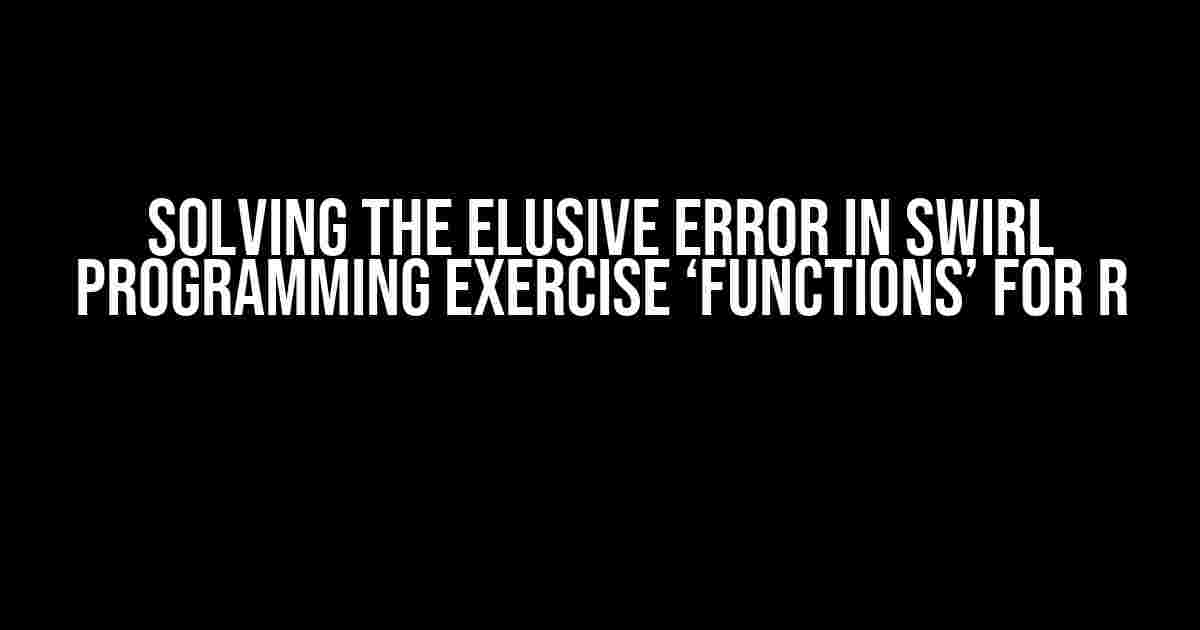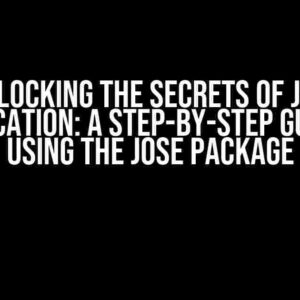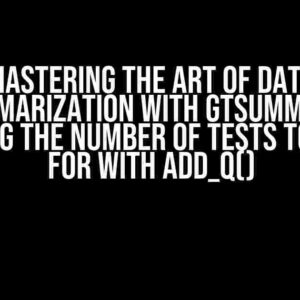Are you stuck on the Swirl programming exercise ‘functions’ for R? Don’t worry, you’re not alone! This article will guide you through the troubleshooting process, providing clear and direct instructions to help you overcome the error and master the art of creating functions in R.
Understanding the Error
The error in question typically manifests as a cryptic message, leaving you wondering what went wrong. It may look something like this:
Error in swirl("functions") :
Could not find function "swirl"Or, perhaps you’re seeing an error message related to the installation of the swirl package:
Error in install.packages("swirl") :
unable to install packageBefore we dive into the solution, let’s take a step back and understand what’s causing the error.
The Swirl Package
Swirl is an interactive tutorial platform designed to teach you R programming in a hands-on, immersive environment. The ‘functions’ exercise is one of the many interactive lessons available on the platform. To access the exercise, you need to have the swirl package installed and loaded in your R environment.
Troubleshooting the Error
Now that we’ve established the context, let’s get down to business and troubleshoot the error. Follow these steps to resolve the issue:
-
Check if you have the swirl package installed:
installed.packages()["swirl"]If the package is not installed, proceed to the next step.
-
Install the swirl package:
install.packages("swirl")This may take a few minutes, depending on your internet connection and system configuration.
-
Load the swirl package:
library(swirl)Make sure you don’t see any error messages after loading the package.
-
Access the ‘functions’ exercise:
swirl("functions")If you’re still encountering an error, try restarting your R environment and then retry the above step.
Common Pitfalls and Solutions
Even after following the troubleshooting steps, you might still encounter issues. Here are some common pitfalls and their solutions:
| Pitfall | Solution |
|---|---|
| Outdated R version | Update your R version to the latest release. |
| Conflicting package versions | Check for updates to the swirl package and other dependencies. Use update.packages() to update all packages. |
| Corrupted package installation | Reinstall the swirl package using install.packages("swirl", dependencies = TRUE). |
| R environment not restarted | Restart your R environment after installing or updating packages. |
Mastering Functions in R
Now that you’ve overcome the error, it’s time to dive into the world of functions in R! A function is a block of code that performs a specific task, making your code more organized, efficient, and reusable.
Defining a Function
To define a function in R, use the function() keyword followed by the function name, arguments, and the code block:
hello_world <- function(name) {
paste("Hello, ", name, "!", sep = "")
}Call the function by passing the required arguments:
hello_world("John")Functions in the 'Functions' Exercise
In the Swirl 'functions' exercise, you'll learn to create and work with functions in R. You'll practice writing functions to perform arithmetic operations, manipulate strings, and more.
One of the exercises might ask you to create a function that adds two numbers:
add_numbers <- function(x, y) {
x + y
}Then, you'll be asked to call the function with specific arguments:
add_numbers(2, 3)Conclusion
By following this article, you should now be able to overcome the error and successfully complete the Swirl 'functions' exercise in R. Remember, practice makes perfect, so be sure to experiment with different functions and scenarios to solidify your understanding.
Swirl is an excellent resource for learning R, and with persistence and patience, you'll become proficient in no time. Happy coding, and don't hesitate to reach out if you have any further questions or need additional assistance!
Additional Resources
If you're interested in learning more about functions in R or need further guidance, here are some additional resources:
-
The Official R Documentation: https://www.rdocumentation.org/
-
R Tutorial by DataCamp: https://www.datacamp.com/tutorial/r-tutorial
-
Swirl Website: https://swirlstats.com/
Frequently Asked Question
Get the scoop on the most common conundrums faced by R enthusiasts in the Swirl Programming exercise 'functions'!
Why do I get an error when I try to call a function with the wrong number of arguments?
Hey there! In R, when you define a function, you specify the number of arguments it expects. If you try to call that function with a different number of arguments, R will throw an error. So, double-check the function definition and make sure you're passing the correct number of arguments. Easy peasy!
How do I fix the error "could not find function" in Swirl's 'functions' exercise?
Don't sweat it! This error usually means you haven't defined the function correctly or haven't loaded the necessary package. Review your code, make sure you've defined the function properly, and if necessary, load the required package using the library() function. Then, try calling the function again!
Why does my function return NULL when I'm expecting a value?
Hmm, that's a good question! In R, if a function doesn't explicitly return a value using the return() statement, it defaults to returning NULL. So, make sure you're using the return() statement to explicitly return the value you want. That should fix the issue!
Can I use the same name for a function and a variable in R?
Good question! In R, it's technically possible to use the same name for a function and a variable, but it's not recommended. This can lead to confusion and unexpected behavior. To avoid headaches, use unique names for your functions and variables. Trust us, your code (and your sanity) will thank you!
What's the difference between <- and = when assigning values in R?
In R, both <- and = can be used for assignment, but there's a subtle difference. <- is the assignment operator, while = is used for parameter assignment in functions. So, for general assignments, use <-, and for function parameters, use =. Got it? Good!




